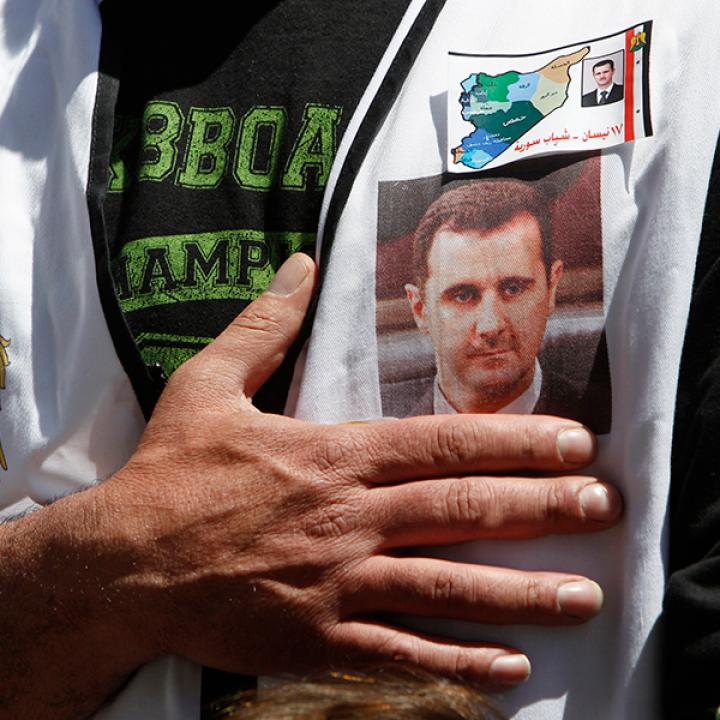

The Druse cannot bet on the still-fragmented Syrian opposition to protect them.
In March 2011, two days before massive protests erupted in Syria, President Bashar Assad and his wife Asma paid a visit to the southern province of Suwayda, the country's Druse heartland. On the surface, the purpose of their visit was to check up on a development project for villages suffering from a drought. That Assad would visit Suwayda when a revolution was brewing in neighboring Deraa should have raised eyebrows; knowing that the Druse fronted historic rebellions in Syria, such as the Great Revolution (1925-1927) against the French, could Assad have been worried that this community could turn against him? Just days later, Druse lawyers in Suwayda began voicing their solidarity with the opposition. Protests soon followed. In early 2013, a group of Druse mashayekh (clerics) admonished brigadier Issam Zahreedine, a Druse officer in the regime's army, who, according to Human Rights Watch, ordered most of the beatings of protesters in Douma early on in the uprising.
But these clerics, in support of cutting all ties with "people bearing arms who are part of any side," were equally against those Druse who have joined the opposition -- including Khaldoun Zeineddine, who defected as a first lieutenant in the regime's army to form the so-called Sultan Pasha al-Atrash battalion, aligned with the Free Syria Army (FSA).
However, the majority of the Druse have chosen to tiptoe around this conflict. Their silence is strategic: previous uprisings by this community have been suppressed by the regime, including in November 2000, when they clashed with Beduin largely to avenge the murder of Wasim Fahd, a Druse farmer. And in the current conflict, the community has paid its fair share of blood: fighters on both sides, unarmed protesters and even artists, such as Tamer Awam, a Syrian Druse filmmaker killed in Aleppo while covering events for the FSA.
"We have found ourselves between a hammer and an anvil," said a Syrian from Suwayda living in Lebanon. The Druse are stuck between a regime that they silently dislike and Islamic extremists. In January 2014, a handful of Druse marked the death of one of their co-religionists, Salah Sadeq, a young activist who reportedly died during a regime offensive in Aleppo. Even though Sadeq was killed by the regime, the demonstrators chose this occasion to censure an enemy that has them far more worried: radical Islamists. They shouted, "Out to the Islamic State in Iraq and the Levant [a former al-Qaida affiliate]!" Extremists in Syria have indirectly pushed minority groups into the regime's camp. The stance taken by the Syrian Druse shows the reasons behind this disturbing trend. Extremists may, oddly, be doing Assad's public relations work. Earlier this year, reports surfaced that Islamists have forced some Druse in the northern province of Idlib to convert, something that the regime has never done.
For this community, accepting Assad is not an easy choice. However, given the role of extremists, it could be their only one. This serves to reinforce Assad's claim that he is the protector of minorities, when in reality he is just the least bad option.
But this was not always the case. On March 27, 2011, a few days after the uprising began in Deraa, lawyers in Suwayda issued a statement of solidarity with the protesters. They called for lifting the security siege on Sunni-majority Deraa, while opening "a serious investigation" into incidents during which unarmed civilians were targeted with live ammunition. But in two years' time, the relationship between Suwayda and Deraa has taken a turn for the worse.
According to Sheikh Hamoud Hanawi, a leading Druse cleric, kidnappings have occurred between the two neighboring provinces. The Druse agreed to release their hostages, but following negotiations, the abductors in Deraa refused to follow suit. Mouwafaq Riziq, the brother of one of the Druse abductees, himself a member of the opposition, blamed Jabhat al-Nusra, an al-Qaida affiliate, for the kidnappings.
The experience of the Druse provides an important insight about the Syrian conflict going forward: The key to weakening the regime is to provide minorities with an alternative to protect them, or at the very least not attack them. A revolution has been lost in Syria. At the beginning, the Druse were able to call for freedom and human dignity. This is no longer what the conflict is about. Once a protest movement, it is now a militarized rebellion, and the Druse have no choice but to stay away from crises that threaten their survival and unity.
The crisis is a dynamic one, and so is the Druse's plan for survival. It is uncertain whether the country will be partitioned, and if Quneitra and Deraa, which both border Suwayda, will fully return to Assad's orbit. What will happen if the Druse wind up in opposition-controlled territories, in an ocean of Sunnis, remains to be seen. But currently, their vision for the future of Syria can be summed up by the most common slogan chanted by Druse protesters: "Souriya wahida," Syria is one. The alternative to a united Syria bodes ill for this community.
During the regime of Adib Shishakli (1950-1954), Druse rights in Syria were under threat. Under the watch of this Sunni president, many of them had to flee to Lebanon. Others were killed when the military opened fire on Druse demonstrators in 1953. Although the Druse were later active in Shishakli's ouster, they don't seem to be following the same course regarding the current regime, despite its heinous crimes. The Druse cannot afford to break ties with any party, even though a fragmented opposition, for the time being, appears to be a losing bet.
Noam Raydan and Adam Heffez are research assistants at The Washington Institute.
Jerusalem Post



